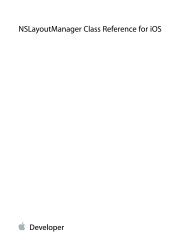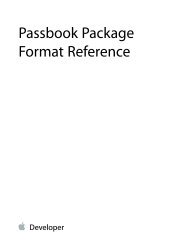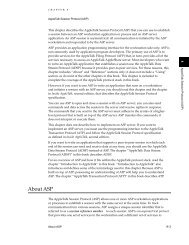URL Loading System Programming Guide - Apple Developer
URL Loading System Programming Guide - Apple Developer
URL Loading System Programming Guide - Apple Developer
Create successful ePaper yourself
Turn your PDF publications into a flip-book with our unique Google optimized e-Paper software.
Cookies and Custom Protocols<br />
Protocol Support<br />
Note: Changing the cookie acceptance policy in an app affects the cookie acceptance policy for all<br />
other running apps.<br />
When another app changes the cookie storage or the cookie acceptance policy, NSHTTPCookieStorage<br />
notifies an app by posting the NSHTTPCookieManagerCookiesChangedNotification and<br />
NSHTTPCookieStorageAcceptPolicyChangedNotification notifications.<br />
For more information, see NSHTTPCookieStorage Class Reference and NSHTTPCookie Class Reference .<br />
Protocol Support<br />
The <strong>URL</strong> loading system design allows a client app to extend the protocols that are supported for transferring<br />
data. The <strong>URL</strong> loading system natively supports the http, https, file, ftp, and data protocols.<br />
You can implement a custom protocol by subclassing NS<strong>URL</strong>Protocol and then registering the new class<br />
with the <strong>URL</strong> loading system using the NS<strong>URL</strong>Protocol class method registerClass:. When an<br />
NS<strong>URL</strong>Session, NS<strong>URL</strong>Connection, or NS<strong>URL</strong>Download object initiates a connection for an NS<strong>URL</strong>Request<br />
object, the <strong>URL</strong> loading system consults each of the registered classes in the reverse order of their registration.<br />
The first class that returns YES for a canInitWithRequest: message is used to handle the request.<br />
If your custom protocol requires additional properties for its requests or responses, you support them by<br />
creating categories on the NS<strong>URL</strong>Request, NSMutable<strong>URL</strong>Request, and NS<strong>URL</strong>Response classes that provide<br />
accessors for those properties. The NS<strong>URL</strong>Protocol class provides methods for setting and getting property<br />
values in those accessors.<br />
The <strong>URL</strong> loading system is responsible for creating and releasing NS<strong>URL</strong>Protocol instances when connections<br />
start and complete. Your app should never create an instance of NS<strong>URL</strong>Protocol directly.<br />
When an NS<strong>URL</strong>Protocol subclass is initialized by the <strong>URL</strong> loading system, it is provided a client object that<br />
conforms to the NS<strong>URL</strong>ProtocolClient protocol. The NS<strong>URL</strong>Protocol subclass sends messages from the<br />
NS<strong>URL</strong>ProtocolClient protocol to the client object to inform the <strong>URL</strong> loading system of its actions as it<br />
creates a response, receives data, redirects to a new <strong>URL</strong>, requires authentication, and completes the load. If<br />
the custom protocol supports authentication, then it must conform to the<br />
NS<strong>URL</strong>AuthenticationChallengeSender protocol.<br />
For more information, see NS<strong>URL</strong>Protocol Class Reference .<br />
2013-10-22 | Copyright © 2003, 2013 <strong>Apple</strong> Inc. All Rights Reserved.<br />
63
















